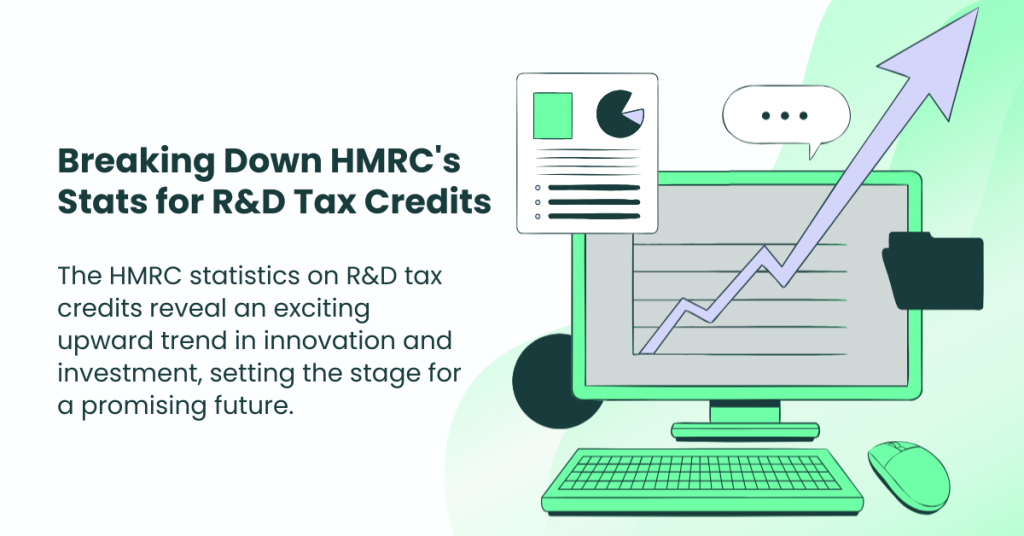An outlook of HMRC R&D tax credit statistics 2023

It’s been an incredible financial year for R&D; innovative projects across the United Kingdom have truly taken off and grown tremendously, fuelled by the cash injection from R&D tax credits for SMEs and large companies. The newly published HMRC R&D tax credit statistics tell us that innovation is evolving in alignment with business needs in the tax year of 2021-2022. There is an upward trajectory of innovation and investment which is highly promising for the years to come. Let’s break down these key R&D statistics and explore the key takeaways.
Key HMRC R&D tax statistics 2023
- The estimated amount of R&D tax relief support was £7.6 billion during the financial year 2021 to 2022.
- The total number of successful R&D claims was 90,315. 87.7% (79,205) of these were for small businesses under the SME scheme and 12.3% (11,115) were for larger companies under RDEC.
- The tax relief payout from R&D claims was 11% higher than the year before with a 5% increase in the number of businesses claiming.
- The value of an average claim increased by 6% in 2021 to 2022.
- There was an 8% increase in R&D expenditure by claimants, therefore £44.1 billion was spent on research and development.
- The sectors responsible for the highest proportion of R&D claims were the Information & Communication Scientific, Manufacturing, and Technical Sectors. Collectively, these made up 62% of the total claims.
- In terms of location, London had the highest percentage of R&D tax credit claims at 22%, followed by the South East at 15%.

To summarise the key HMRC R&D tax credit statistics in 2023, it’s clear it has been a rebound year following the economic impact of the COVID-19 pandemic.
It’s important to keep in mind that R&D tax credits can be claimed retrospectively within a 2-year period so there is other R&D activity from this time period where the claim has not been completed yet and therefore hasn’t been accounted for in these R&D statistics.
What do the R&D statistics tell us?
There are evident trends within the 2023 R&D statistics. Let’s analyse these findings and explore what they mean to help us anticipate what the next year has in store for R&D.
1. The depth of innovation has risen
The R&D tax credit statistics show a range of increases: the number of claims, the amount paid out, expenditure spent, the average value of each claim, and more! This shows the rate of R&D activities has been improved. Businesses across sectors in the UK are pushing the limit by creating brand-new solutions, improving processes, and generally improving Britain’s economy. Businesses are actively recognising the importance of R&D in driving commercial competitiveness and overall growth.
2. Certain industries are embracing innovation
Following the point that innovation is on the rise, another partial reason for this is that the awareness of R&D tax credits has grown. Naturally, certain industries are going to be more aware of the tax incentive and others may not know their everyday work is eligible for R&D. The leading claimants work in the manufacturing and information and communication sectors, making up 23% of the total R&D claims.
From our own client base, the highest number of R&D claims we completed in the financial year of 2021-2022 were within the IT and Software Development industry, specifically companies innovating with Artificial Intelligence.
There were very few R&D claims within electricity, gas, steam, air conditioning, public admin, defence, and social science. This means that our role at Alexander Clifford is not only to complete R&D claims but to spread the mission of R&D further to these industries to ensure no one eligible misses out on the invaluable boost that the tax incentive creates for UK businesses.
3. There are hotspots of innovation and gaps across the UK
Where is innovation taking place? London has always been a hotspot of R&D but we’re seeing businesses across the UK take advantage of the incredible mission of R&D. With 22% of total claims coming from London-registered offices, the South East follows with 15% of total claims as well as an increase in overall spending, rising from £6.1 billion to £7.3 billion. The claimed amount has also surged from £1 billion to £1.2 billion.
The lowest amount of R&D claims were in Northern Ireland, followed by Wales.
It’s important to note that the registered office addresses may not necessarily correspond to the actual location where all the R&D activities are being conducted.
4. The increase of brand new projects starting their R&D journey
Looking at the R&D statistics, it’s very interesting that 69% of the claims fell within the bracket of up to £50,000 of R&D expenditure (the SME scheme). What this tells us is that there was a huge proportion of much smaller projects as opposed to projects at a larger scale. A reason for this is businesses are being cautious, and experimenting with a number of different initiatives at one time to carefully monitor the success of the project before investing more.
5. The year of bouncing back
Following a difficult economic time from the COVID-19 pandemic, there was a natural and circumstantial dip in R&D activities and claims. Many businesses were pausing their efforts to embark on advancing technical uncertainties and instead needed to focus on guaranteed profit for business sustainability. Lots of R&D projects commenced as a risk because there was no guarantee that they could achieve what they set out to do. Therefore, it’s evident that during a difficult economic time, research and development might slow down.
Then the financial year of 2021-2022 came and it was the R&D revival, witnessing an 8% increase in R&D spending. This has produced great economic recovery. This was the time period when businesses could justify investing in R&D. This could be another factor for why the Information & Communication and Manufacturing sectors are leading the way in R&D claims. In our client base, traditional manufacturing claims have decreased and automation and digital technologies implemented into manufacturing have been the main claimants.
They contain a digital focus that is essentially pandemic-proof, striving for increased digitalisation and technical advancement that is resilient to the challenges of a low workforce, a pandemic, and more.
Our experience of creating R&D tax credit claims during 2021-2022
As R&D tax credit specialists, we witnessed how these HMRC R&D tax credit statistics played out from start to finish.
Managing Director of Alexander Clifford, Andrew Dean, described: “What stands out most to us is how more businesses are increasingly aware of RDEC. Now the RDEC rate has increased from April 2023, it’s going to be incredible to support larger companies to complete their claims and receive the rewards they deserve. It was an exciting year, watching industry challenges be analysed and eventually solved through the outside-of-the-box thinking of our clients.”
The prevalent challenges of R&D claims during this period
The main challenges that arose for our clients before opting to work with an R&D tax credit specialist were:
- Understanding the R&D rate and eligibility – The rate for RDEC and R&D tax credits has changed and evolved regularly over the previous few financial years. Businesses attempting to complete their own R&D claim or accountants without an R&D background have struggled to calculate the correct figures in their claims as well as knowing the scope of eligibility to ensure their claim is 100% optimal.
- Preventing and resolving HMRC enquiries – HMRC are being increasingly vigilant over all R&D claims to prevent misuse of the incentive. We’ve seen certain industries have been selected by HMRC as the most likely to have fraud meaning there have been more HMRC enquiries and delays in the payment of the financial reward until the enquiries have been solved. Each R&D claim needs to be meticulously checked and proofread before it is submitted, so HMRC has all the information they need.
A wrap-up of HMRC’s R&D statistics
In conclusion, the HMRC R&D tax credit statistics 2023 provide insight into the progress of innovation across the UK and the economic impact of this innovation we can expect in years to come. The breadth and diversity of R&D is broad which is why we always encourage you to check if you’re eligible with a member of our team. This means you don’t miss out and there’s no upfront cost to you. We can’t wait to see what the next financial year reveals about R&D trends.







